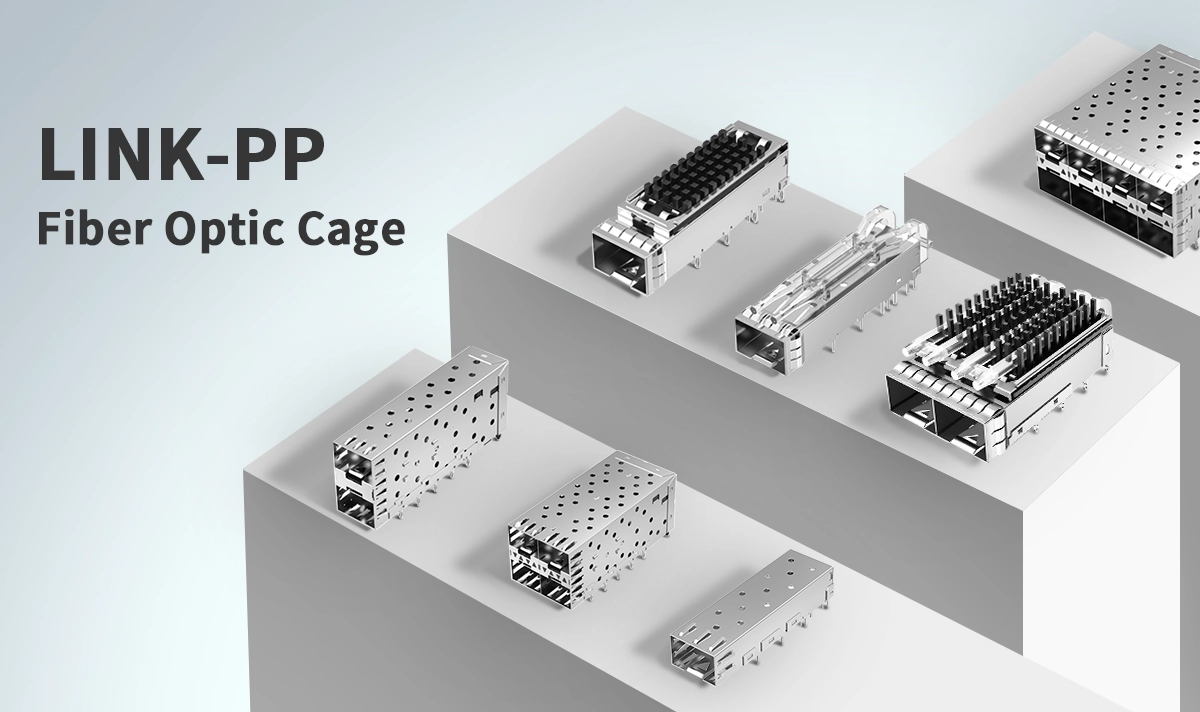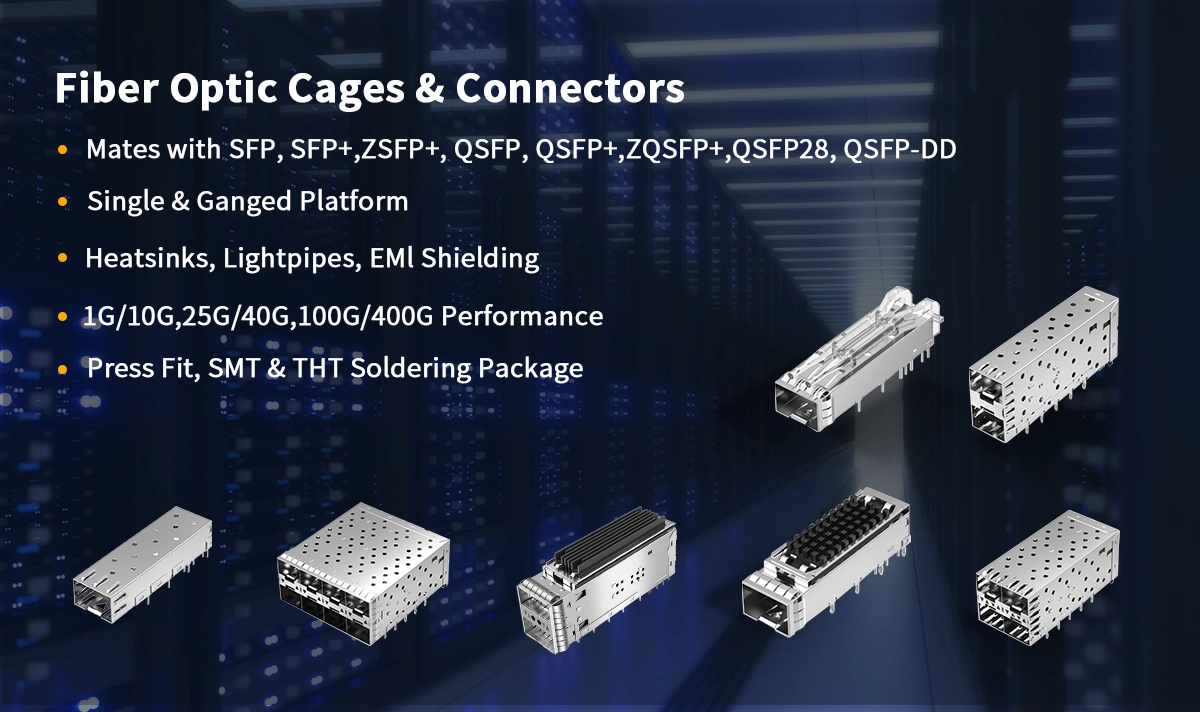
In the high-speed world of networking, Small Form-factor Pluggable (SFP) modules are ubiquitous. But the unsung hero ensuring their seamless operation, optimal signal integrity, and physical stability is the SFP cage (or fiber optic cage). Choosing the wrong cage can lead to a cascade of problems: unreliable connections, overheating modules, difficulty inserting/removing optics, electromagnetic interference (EMI), and even premature hardware failure. This guide cuts through the complexity, providing network engineers, data center managers, and procurement specialists with the knowledge to navigate the SFP cage selection process confidently. We'll explore classifications, critical features, and best practices, highlighting where LINK-PP's precision-engineered solutions excel.
➣ Understanding the SFP Cage: More Than Just a Socket
An SFP cage is a metal frame assembly soldered onto a host board (like a switch, router, or network interface card). It provides:
Secure Physical Housing: Precisely holds the SFP module in place.
Electrical Interface: Connects the module's electrical contacts to the host board via a connector.
EMI Shielding: Critical metallic enclosure prevents electromagnetic interference from disrupting sensitive electronics.
Thermal Management Path: Facilitates heat dissipation from the module (often via contact with a heatsink).
Latching Mechanism: Secures the module and allows for safe, tool-less insertion/removal.
Alignment: Ensures the optical port aligns correctly with faceplate openings or light pipes.
➣ Classification by Accommodated Module Type: Compatibility is King
The most fundamental classification is the type of optical module the cage is designed to hold. Using an incompatible cage is a non-starter.
SFP Cages: Designed for standard SFP (1G) and SFP+ (10G) modules. These are the most common.
SFP28 Cages: Specifically designed for SFP28 modules (25G). Using a cage rated for SFP28 ensures optimal signal integrity at 25Gbps speeds, crucial for high-speed cage requirements. LINK-PP's zSFP+ Cage is optimized for 25G/28G applications.
QSFP/QSFP+/QSFP28/QSFP-DD Compatibility: Crucially, standard SFP cages do NOT accommodate QSFP family modules. These larger, higher-density modules require their own specific, larger cages (QSFP cages). Ensure your cage selection matches the module form factor.
Combo Cages (SFP/SFP+ & SFP28): Versatile cages designed to accept both SFP/SFP+ modules and SFP28 modules. Ideal for platforms needing flexibility or future upgrades. Check datasheets for specific supported module types.
➣ Classification by Port Count & Density: Fitting Your Needs 1U, 2U, 4U...
EMI Cages are designed to fit specific port configurations on host boards and chassis faceplates. Density is a major factor in switch cage design and router cage specs.
Single-Port Cages: Hold one optical transceiver. Common in NICs, lower-density switches, or specific applications.
Dual-Port Cages: Hold two optical modules side-by-side. A very common configuration for high port density requirements in 1U/2U equipment. Requires precise spacing (SFP cage pitch).
Quad-Port Cages: Hold four SFP modules. Used in higher-density switches and line cards. Demands excellent thermal management design.
High-Density Cages (6-Port, 8-Port, 16-Port, 24-Port): Engineered for maximum port density in constrained spaces (e.g., top-of-rack switches, core routers). These pose significant challenges in thermal management, EMI control, and mechanical stability. LINK-PP's LP28AC01101 exemplifies robust design for 16-port applications, featuring integrated light pipes.
Table 1: Common SFP Cage Port Configurations & Applications
Port Count | Typical Pitch | Common Applications | Key Considerations |
|---|---|---|---|
1-Port | N/A | NICs, Low-density Switches, Specialized Gear | Simplicity, Cost |
2-Port | ~15.5mm | Most Enterprise Switches, Routers, Media Conv | Balance of density & thermals, Very Common |
4-Port | ~15.5mm or ~12mm | Higher-density Switches, Server NICs | Thermal management becomes critical |
6-Port+ | Often ~12mm | High-Density ToR Switches, Core Router Line Cards | Critical: Advanced Thermal Design, EMI Shielding, Robust Latch Mechanism. Requires high-quality |
➣ Classification by Light Pipe (Light Guide / Optoguide) Integration: Seeing the Light
Status LEDs on the SFP module need to be visible on the equipment's front panel. Light pipes (often made of acrylic or polycarbonate) transmit this light.
Cages WITHOUT Integrated Light Pipe: The cage itself has openings where the module's LEDs are located. A separate light pipe assembly, mounted on the chassis faceplate, must be precisely aligned with these cage openings during assembly. Requires careful mechanical design tolerance.
Cages WITH Integrated Light Pipe: The light pipe is physically part of the cage assembly. It extends from the LED position on the module up to the front profile of the cage. This guarantees perfect alignment and often simplifies chassis faceplate design, improving reliability. Essential for cages for high-density switches where alignment tolerance stacking is a major risk. LINK-PP offers many sfp cages (e.g., LP11BC02100) with integrated, high-transmission light pipes as standard or optional features.
➣ Classification by Heatsink Integration: Keeping Your Cool
Higher-speed modules (especially SFP28, 10G SR/LR over longer distances, BiDi) generate significant heat. Effective cooling is paramount for module longevity and signal stability. Cages play a vital role in the thermal path.
Cages WITHOUT Integrated Heatsink: Rely solely on:
Airflow within the chassis.
The module's own minimal heatsink (if any).
Sometimes contact with a heatsink plate mounted on the chassis cage row cover. Can be sufficient for lower-power 1G/10G modules in well-cooled environments but risky for higher power or dense configurations.
Cages WITH Integrated Heatsink: Feature a thermally conductive metal structure (often aluminum or copper alloy) as part of the cage body. This structure:
Makes direct contact with the top metal shell of the SFP module.
Provides a large surface area to dissipate heat into the surrounding air or conduct it to a larger chassis heatsink.
Is ESSENTIAL for thermal management in SFP28 cages, high-power modules (e.g., 10G ER/ZR, DWDM), and high-density cage applications. For example, LINK-PP's LP11BC02060 or LP11BCS2050 is renowned for their superior heatsink designs, significantly lowering module operating temperatures.
Table 2: SFP Cage Heatsink Options & Recommendations
Heatsink Type | Description | Best For | Not Recommended For |
|---|---|---|---|
No Integrated Heatsink | Relies on airflow/module design/chassis cooling | Low-power 1G SFP, Short-reach 10G in cool environs | SFP28, High-Power 10G (ER/ZR, DWDM), Dense |
Basic Integrated Heatsink | Cage includes simple thermal mass/extended surface area | General 10G SFP+, Moderate density | Extreme density, Highest power modules |
Advanced Integrated Heatsink | Optimized fin design, high-conductivity materials (e.g., LINK-PP HS) | Critical: SFP28, High-Power Optics, High Port Density, Hot environments | Budget-sensitive, low-power/low-density only |
➣ Spotlight on Performance & Reliability: Why LINK-PP Stands Out

LINK-PP has built a reputation as a leader in high-performance interconnect solutions, including a comprehensive range of fiber optic cages engineered for demanding applications:
Uncompromising Quality: Rigorous manufacturing processes and quality control ensure dimensional precision, material integrity, and reliable plating.
Superior Thermal Management: Our sfp cages feature patented heatsink designs using high-conductivity materials and optimized fin structures, demonstrably lowering module operating temperatures by 10-15°C compared to standard cages – crucial for thermal management and longevity.
Optimized for High Density: Cages like the LP28BC01301 is specifically engineered for the extreme challenges of 16-port configurations, integrating lightpipes and robust EMI shielding without compromising on port density.
Integrated Light Pipes: Offering clarity and guaranteed alignment, reducing assembly complexity and potential points of failure. (e.g., LP11BC02100, LP22AC01101).
Comprehensive Range: From standard SFP+ to high-performance SFP28 and high-density solutions, LINK-PP has the right cage for your specific SFP cage types and cage selection needs.
Global Support & Availability: Trusted by leading OEMs worldwide with reliable supply chains.
➣ Making the Right Choice: Your SFP Cage Selection Checklist
Use this actionable checklist on your next project:
Module Type: SFP/SFP+ or SFP28? Future SFP28 needs? (Requirement: SFP cage compatibility)
Port Count & Density: Single, Dual, Quad, High-Density (6P+)? What's the required pitch? (Requirement: switch cage design, high port density)
Thermal Load: Are you using high-power modules (e.g., ER/ZR, DWDM, BiDi, SFP28)? What's the ambient temperature? (Requirement: Integrated Heatsink?)
Light Pipe: Does the chassis design require integrated light pipes for reliable LED visibility? (Requirement: Cages WITH Integrated Light Pipe)
EMI Compliance: Is the equipment subject to strict EMI regulations (FCC, CE)? (Requirement: High-quality EMI shielding)
Vendor Reliability: Can you trust the consistency and longevity of the cage? (Recommendation: Choose established brands like LINK-PP)
➣ Conclusion: Don't Underestimate the Cage!
Selecting the right SFP cage is not a trivial component choice; it's a foundational decision impacting network performance, reliability, thermal management, and operational ease. By understanding the classifications – module type, port density, light pipe integration, and crucially, heatsink options – and prioritizing factors like EMI shielding, material quality, and vendor reputation, you can avoid costly pitfalls. For mission-critical applications, demanding thermal environments, or high-density deployments, investing in high-performance cages from a trusted leader like LINK-PP is not just wise, it's essential insurance for your network infrastructure.
🔧 Ready to Optimize Your Hardware? 🔧
Don't let an underspec'd cage become your network's weakest link! Contact the LINK-PP technical team today for expert guidance on selecting the perfect SFP cage for your specific switch, router, or line card design. Explore our full range of high-performance SFP, SFP+, and SFP28 cages – including our industry-leading HS (Heatsink) and LP (Light Pipe) series – on the LINK-PP website. Ensure superior signal integrity, thermal performance, and reliability. Request samples or a quote now! ➡️




